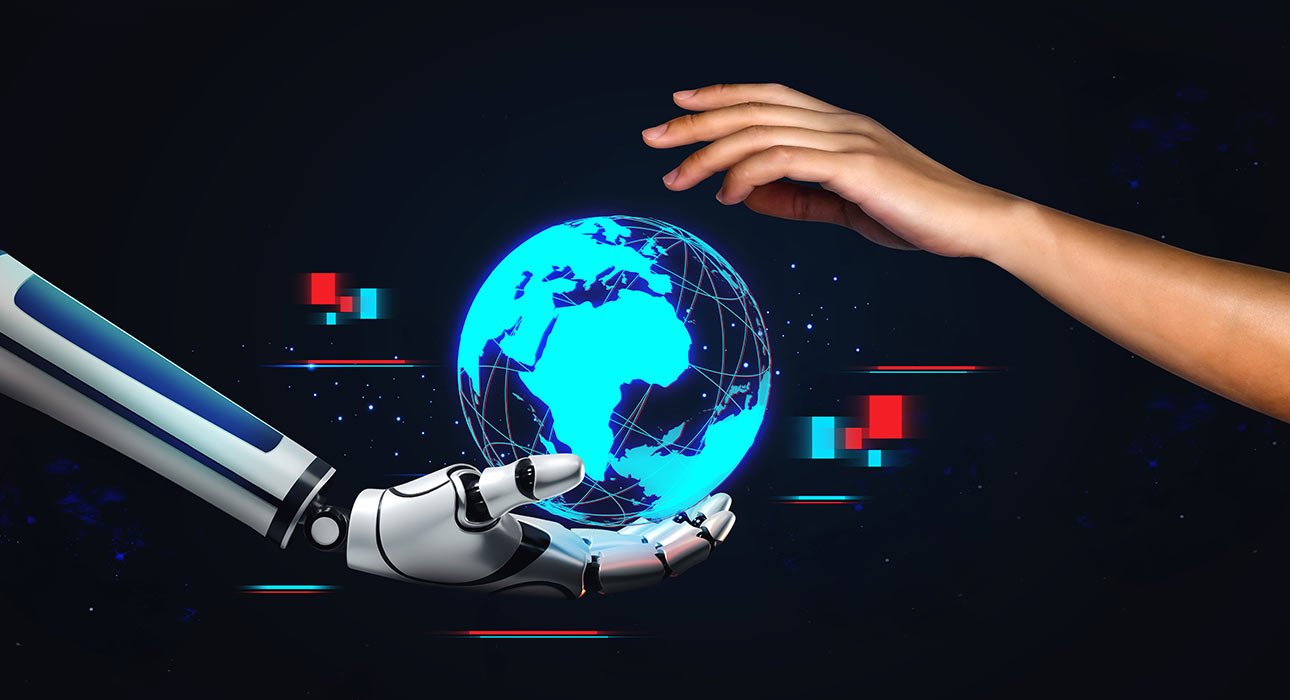“Just imagine a city where a new AI app promises to make daily life easier, from helping with job searches to booking appointments. But for some people, especially those who don’t speak the dominant language or don’t have good internet access, the app feels confusing or even useless. For others with disabilities, the app’s design isn’t friendly or accessible.”
This example raises a critical question for us all: as AI technologies expand, will their benefits truly reach to everyone or will some communities be left behind? While AI is undoubtedly a powerful tool, its impact hinges on who designs it, who has access to it and whether inclusivity is a priority. This article will explore AI’s visionary potential and the barriers it must overcome to become truly inclusive.
Understanding AI and Social Inclusion
AI refers to computer systems designed to perform tasks that normally require human intelligence, such as decision making, pattern recognition and language processing. While AI advancements promise solutions to many global challenges, inclusivity in AI is not simply about access to gadgets. It means :
- Ensuring the inputs (data & design) reflect the full diversity of the world.
- Ensuring the systems’ outcome and behaviours serve all users fairly.
- Ensuring that the development, governance and deployment of AI engage and deployment of AI engage and represent under-served communities,
Without these considerations, AI may reinforce or magnify the very inequalities it promises to reduce. The Power of AI and Its Limits. AI now influences everything: healthcare, education, transport, and business. It’s detecting cancers, translating languages, optimising traffic and even writing code. The possibilities seem endless. But these benefits don’t reach everyone equally.
Read More: Decision-Making and the Brain: Neuroscience of Choice and Emotion
The Potential: What AI can Do for All
There are genuine and compelling opportunities for AI to create positive change across diverse populations:
- Healthcare & Diagnostics: AI-enabled imaging, remote diagnostics and personalised algorithms can bring expert-level care to remote or underserved regions.
- Education & Learning Equity: Adaptive learning platforms adjust to individual strengths and weaknesses, potentially offering underserved students high-quality instruction at scale.
- Employment & Accessibility: Automation and AI assistants can empower workers with disabilities or those in informed sectors, levelling the playing field. For example, speech-to-text models and AI-enabled interfaces reduce barriers.
Read More: The Psychological Effects of Automation: Job Security and Mental Health
Social Services & public infrastructure
AI can optimise resource distribution, anticipate disaster responses or improve public transit in under-connected regions.
1. Cultural & Linguistic inclusion
Tools that support regional languages, dialects and audio-visual accessibility widen the audience of technology beyond English or high-income markets. In each case,” for all” potential hinges upon an inclusive foundation rather than incidental access.
Read More: AI Chatbots for People with Disabilities: Bridging the Accessibility Gap
The Barriers: why AI may Exclude
The promise is real, but so are the pitfalls. Some of the key obstacles to inclusive AI include:-
- Data & Design Bias: An AI system inevitably reflects the data they are trained on. If that data lacks representation of women, minority ethnicities, disabled users or low-income communities, the resulting system may perform poorly, depending on internet connectivity, digital literacy and affordability. Marginalised communities for those groups. A meta review of inclusion AI shows consistent gaps in the representation of bias-related challenges.[3]
- Limited inclusivity in AI development: Most AI researchers and developers come from limited demographic backgrounds, impacting whose needs and perspectives shape AI systems(West et al.,2019)
- Digital Infrastructure divide affordability; connectivity, device access and digital literacy remain uneven globally. A World Economic Forum article underscores that billions remain offline, making them invisible to many AI systems.[4]
- Homogenous development & Governance: When AI teams lack diversity in gender, culture, ability or geography, blind spots emerge. A recent call to an actor highlighted that AI development must integrate diverse human perspectives as foundational, not optional.[5]
- Language, Culture & Context: Many AI tools assume English, standard accents or Western cultural norms. In healthcare, a review found marginalised populations were insufficiently represented in AI systems, risking inequitable outcomes.[1]
- Trust, Ethics & Policy gaps: When users feel excluded, mishandled by AI systems, trust erodes. Without rigorous oversight, transparency and participatory governance, AI may reinforce power imbalances rather than counter them.
Examples: Where inclusion is and isn’t happening
- Positive Example: An internal study by Microsoft found that neurodivergent and disabled employees using an AI assistant reported improved productivity and sense of belonging: 75% said the tool helped them do better work and feel more included.[2]
- Cautionary Case: An investigation by WEIRED found OpenAI’s video generator “sora” produced stereotypical and exclusionary images, underrepresenting marginalised groups and reinforcing biases. [7] AI Literacy and inclusive STEM programs targeting underrepresented groups are crucial. They build both user competence and development talent for the future.
The Promise of AI for Everyone
- Healthcare AI: Algorithms designed to safeguard health performed poorly for minority groups due to underrepresentation in training data, leading to misdiagnoses. ( Obermeyer et al., 2019).
- AI-powered recruitment system: Some AI recruitment tools demonstrated gender bias by favouring male candidates, replicating workplace inequalities ( Dastin, 2018).
These examples emphasise the importance of careful design and continuous monitoring to avoid exclusionary outcomes.
Read More: Artificial Intelligence and Alzheimer’s Disease Early Detection: Study
Signs of Progress: What Inclusive AI Looks Like
Despite various hurdles, some innovations are paving the way:
- Google’s Project Euphonia: That helps people with speech impairments communicate more clearly using AI.
- India’s Bhashini Initiative: This develops AI in regional languages that helps people with different regional languages to benefit.
- Be My Eyes: This AI program is used to assist visually impaired users in navigating the world.
- Bias Audits: This program helps people to clean AI hiring tools and financial algorithms.
Steps Toward Inclusive AI
To harness AI’s benefits for all, key strategies include :
- Diverse and Representative Data: Ensuring training datasets include varied demographics reduces bias. Collaborations with local communities help capture relevant contexts.
- Inclusive AI design: Design processes must incorporate input from marginalised groups, including disability advocates, women and ethnic marginalised groups.
- Bridging the Digital Divide: Investing in infrastructure, affordable internet, and digital literacy programs enables equitable access to AI technologies.
- Transparent and Accountable AI: Clear explanations of AI decisions and ethical frameworks prevent misuse and build trust.
- Policy and Regulation Governments must regulate AI to protect rights and enforce inclusivity standards.
The Role of Education and Awareness
To close the gap, we must educate widely, not just engineers but everyday citizens, about AI. When more people understand AI, they can
- identify bias
- Demand ethical use
- Co-create better tools
Special focus should be on empowering underrepresented groups like women, marginalised groups, and persons with disabilities through STEM training and access to AI tools.
The Promise of AI for Everyone
AI has the capacity to bring meaningful, positive changes to people’s lives across demographics:
- Healthcare: AI-enabled health assessments and personalised medicine can improve outcomes for patients worldwide, including remote and underserved regions.
- Education: Intelligent tutoring systems can provide a personalised learning journey to individuals, making quality education accessible to diverse learners.
- Employment: machine-driven operations can free humans from monotonous tasks, allowing focus on creativity and problem-solving.
- Accessibility: AI tools such as speech recognition, real-time transaction, and assistive devices empower people with disabilities.
- Public Services: AI can optimise transportation, energy use and disaster response, enhancing quality of life.
These possibilities indicate a future where it could level the playing field, reducing barriers caused by geography, physical ability or socioeconomic status. Educating AI developers, policymakers, and users about bias, ethics, and inclusivity is a vital curricula that encourage more diverse talent to enter the AI field, furthering equitable innovation.
Looking Ahead: AI for Social Good
Several initiatives highlight AI’s inclusive potential:
- AI-driven mobile health clinics serving remote areas.
- Language translation apps are preserving endangered languages.
- AI-powered tools enabling employment for people with disabilities.
Will AI actually change the World for everyone?
The short answer to this question is It depends. AI‘s capacity to transform lives is enormous, but transformation for everyone depends on choices made today. If tech companies, governments and communities prioritise inclusion, accessibility and justice, AI can be a levelling force. If they do not, AI risks replicating existing inequalities at scale. Imagine: a farmer in a remote region receives localised weather, crop and market insight via AI in her native dialect, a student with dyslexia uses adaptive AI tutoring, A job-seeker with a disability applies through an algorithm audited for fairness. These are plausible futures. But they require that inclusion is baked into the system, not bolted on later.
Read More: New Study Exploring Brain Plasticity in Developmental Dyslexia
Conclusion
Artificial Intelligence offers a monumental opportunity. Yet its impact will only be as deep as our commitment to make it inclusive. For AI to change the world for everybody, we must not merely ask: “Can it?” but “will it?” and if so, how? In the race to build smarter machines, let us not forget the humans behind them. Intentional design, inclusive data, equitable access and shared governance are not optional, but they are essential. AI should expand horizons, open doors and uplift communities, not reinforce the walls around them. The future of AI is not pre-written. If we act with intention, it could become humanity’s most powerful tool for inclusion, but to achieve that, we must ensure no one is left behind.
References +
de Hond, A. A. H., van Buchem, M. M., & Hernandez‑Boussard, T. (2022). Picture a data scientist: a call to action for increasing diversity, equity, and inclusion in the age of AI. JAMIA, 29(12), 2178–2181. [5]
Kamikubo, R., Wang, L., Marte, C., Mahmood, A., & Kacorri, H. (2022). Data representativeness in accessibility datasets: a meta‑analysis. arXiv. [9]
Inuwa‑Dutse, I. (2023). FATE in AI: Towards algorithmic inclusivity and accessibility. arXiv. [10]
Marko, J. G. O., Neagu, C. D., & Anand, P. B. (2025). Examining inclusivity: the use of AI and diverse populations in health and social care. BMC Medical Informatics and Decision Making, 25, 57. [11]
Lung, H. (2025). Designing more inclusive AI starts with data architecture. World Economic Forum. [4]
EY. (2024). Understanding AI bias and inclusivity. EY Insights. [12]
Shams, R. A., Zowghi, D., & Bano, M. (2023). AI and the quest for diversity and inclusion: A systematic literature review. AI and Ethics, 5, 411–438. https://doi.org/10.1007/s43681‑023‑00362‑w [1]
Pagliara, S. M., Bonavolontà, G., Falchi, S., Zurru, A. L., & Fenu, G. (2024). The Integration of Artificial Intelligence in Inclusive Education: A Scoping Review. Information, 15(12), 774. https://doi.org/10.3390/info15120774 [2]
Korada, L., Sikha, V. K., & Siramgari, D. (2024). AI & Accessibility: A Conceptual Framework for Inclusive Technology. International Journal of Intelligent Systems and Applications in Engineering, 12(23s), 983‑? [3]
Gonzalez, A., Crowell, T., & Lin, S. Y‑T. (2024). AI Code of Conduct—Safety, Inclusivity, and Sustainability. JAMA Internal Medicine. https://doi.org/10.1001/jamainternmed.2024.xxx (Advance online) [4] ‘
Shams, R. A., Zowghi, D., & Bano, M. (2023). AI and the quest for diversity and inclusion: A systematic literature review. AI and Ethics, 5, 411–438. https://doi.org/10.1007/s43681‑023‑00362‑w [1]













Leave feedback about this